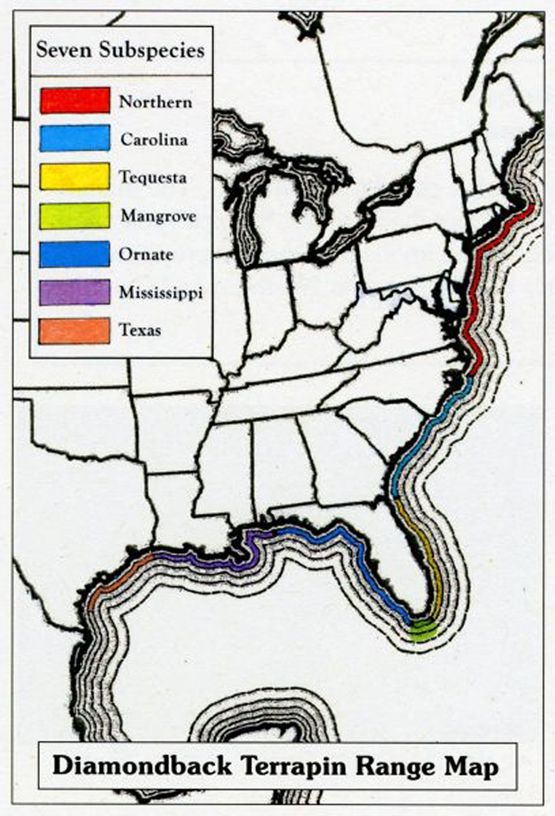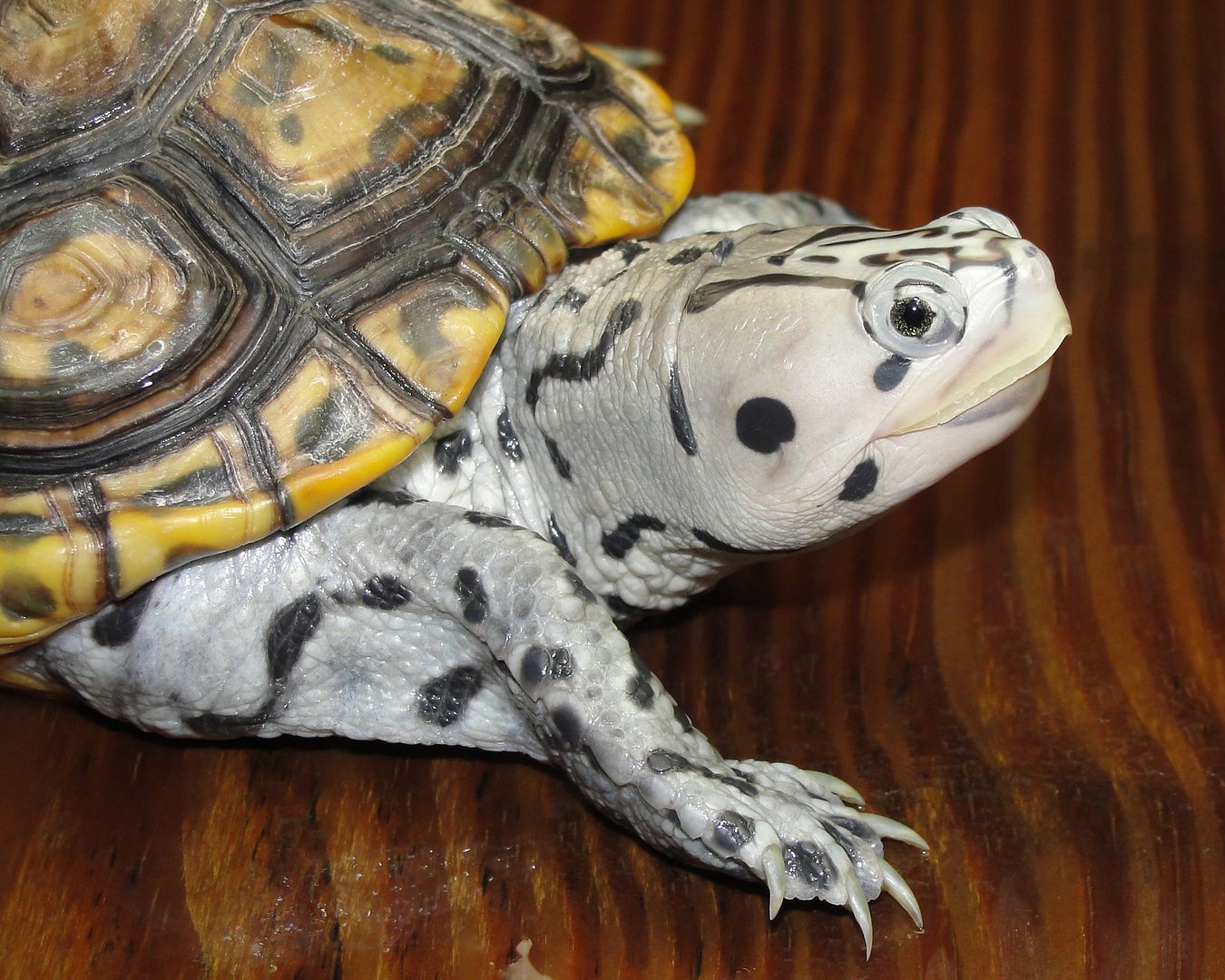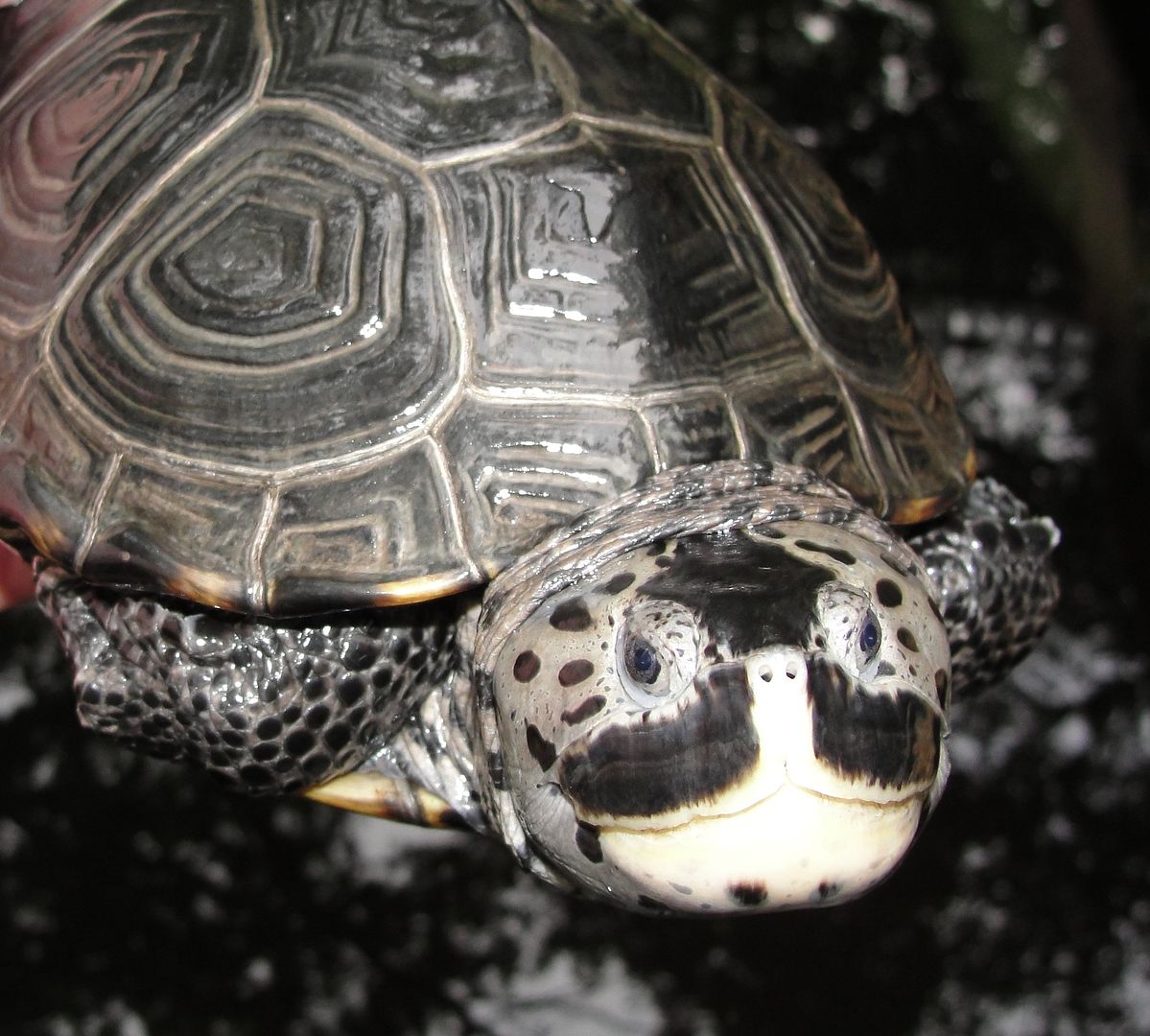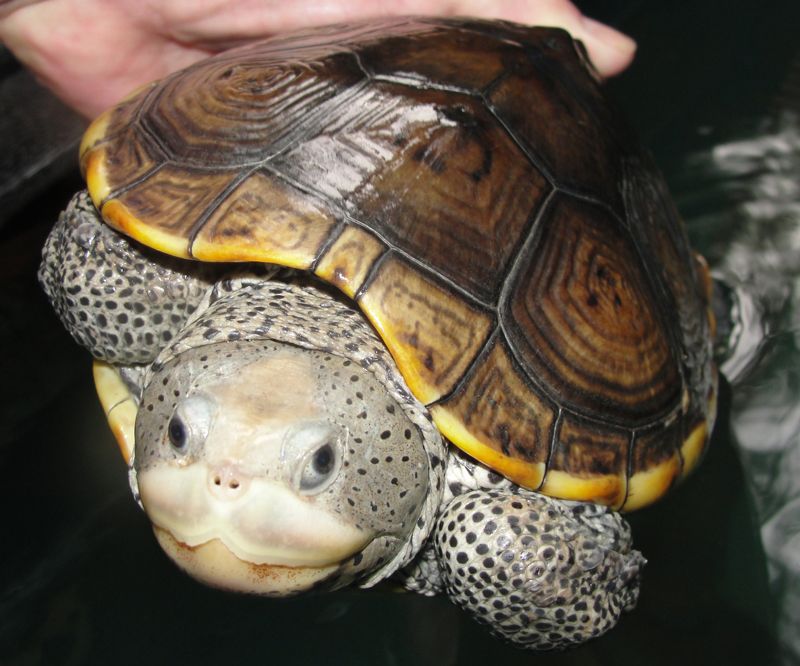You are using an out of date browser. It may not display this or other websites correctly.
You should upgrade or use an alternative browser.
You should upgrade or use an alternative browser.
Anybody seen these???...
- Thread starter Redfoot NERD
- Start date
I saw a DBT for sale on Facebook several months ago for $1000 and I thought it was wishful thinking. What makes them so expensive? Few and far between?
What a beautiful terrapin!
There are several different subspecies. Each subspecies has its own story, including laws most of the time, and each has a different demand among collectors. Then, to make things even more confusing, each individual turtle has its own look, so locality sometimes needs to be known. AND, they intergrade. You really have to hang around and watch DBT adds before you start to get it.I saw a DBT for sale on Facebook several months ago for $1000 and I thought it was wishful thinking. What makes them so expensive? Few and far between?
Ornates, or macros (short for macrospilota, their subspecies name) are a good first lesson to learn in DBTs. They are the ones most often seen in classifieds for larger asking prices. They are much entirely different animals than the DBTs usually offered for lower prices, which are most often Northern DBTs. And Northerns are one of the subspecies that can come in concentric coloration, which can fetch a few extra dollars too.
thomasjnoble
New Member
- Joined
- Oct 5, 2015
- Messages
- 14
Beautiful animals!
There are several different subspecies. Each subspecies has its own story, including laws most of the time, and each has a different demand among collectors. Then, to make things even more confusing, each individual turtle has its own look, so locality sometimes needs to be known. AND, they intergrade. You really have to hang around and watch DBT adds before you start to get it.
Ornates, or macros (short for macrospilota, their subspecies name) are a good first lesson to learn in DBTs. They are the ones most often seen in classifieds for larger asking prices. They are much entirely different animals than the DBTs usually offered for lower prices, which are most often Northern DBTs. And Northerns are one of the subspecies that can come in concentric coloration, which can fetch a few extra dollars too.
All in all you are correct Anthony - and I'm not splitting hairs.. it's integrate (sp) - unfortunately is is now more the rule than the 'norm'.. because of the greed, etc. of man. It is more rare to find a "true" subspecies these days!!! See.. http://turtletary.com/diamond-sub.html
Sorry for my question but which subspecies of terrapin do you keep?
that again juli11 is a relative question --- all in all am keeping both the "East Coast" and "Gulf Coast" .. which show 'subspecie-traits' of them all!
You're right!!It's integrate (sp)
I love their coloration, that pearly white is just stunning!!!!there is a picture of one up there that looks like he's got a mustache! Love it!!! But my favorite ones are those white lips! They look like cartoon characters
Absolutely gorgeous turtles. I am from down south and never seen any like this. Now I live in Ohio so guess I will only see pictures.
Does this help juli11 ? Because of the "mass-integration" that has occurred over the past 'century'.. [ as much as I find it distasteful .. thanks to the science-heads' refusal to accept facts ] the ranges have now been called East Coast ( Atlantic ) and Gulf Coast ( Gulf of Mexico ) - what the modern-day "researchers" [ haha ] are seeing today are mainly INTEGRATES!!! Follow the link in reply to Anthony.
Even the 'macros' shown show different color morphs from their zone 'edges'!
The original 7 ..

Even the 'macros' shown show different color morphs from their zone 'edges'!
The original 7 ..

Don't count on it enchilada ... and besides you have only kept them for a few months.... have no idea why it has been "taught" that it is O.K. to keep these incredible creatures totally foreign to their NATURAL habitat.
Every Terrapin Forum / Facebook anything is loaded with issues that keepers have from keeping their Terrapins in fresh water!!! It costs less to maintain.. filter, etc. in brackish - it's not only better for your Terrapins.. it's the natural way to keep them.
If you want to see how all this works see here - https://www.facebook.com/groups/1576370532623418/
AND... the point of this below is the "INTEGRATES" shown here -
Every Terrapin Forum / Facebook anything is loaded with issues that keepers have from keeping their Terrapins in fresh water!!! It costs less to maintain.. filter, etc. in brackish - it's not only better for your Terrapins.. it's the natural way to keep them.
If you want to see how all this works see here - https://www.facebook.com/groups/1576370532623418/
AND... the point of this below is the "INTEGRATES" shown here -
Berkeley
Active Member
- Joined
- May 4, 2014
- Messages
- 297
....All in all you are correct Anthony - and I'm not splitting hairs.. it's integrate (sp)....
No, Anthony was correct. Diamondbacks have intergrades, not integrates.
To 'Integrate' is combining or putting something together so that it makes a larger unit. Think in terms of schools.
An 'Intergrade' is one group of biological species merging gradually one with another through a continued series of intermediate forms or morphologies. Animals have intergrades, but are not integrated.
To rephrase it a little bit, intergrades are degrees of change within two subspecies, usually referring to where those two subspecies meet. Rat snakes- like the Diamondback Terrapins we are talking about here- are a great example. Most of the eastern US has 'black' rat snakes, but if you go down to the Atlantic coast, and into peninsular Florida, you get yellow rats. Head into the Gulf Coast and the south central US and you have gray rats. However, there is not a clear line of division between any of those phases or groups. There are changes as you head further into one side or another. Basically, the rat snakes do not go from black, to yellow with stripes when you cross a certain highway or state line. There is a degree of change: you have shiny black, then black with some pattern showing through, then just dark with some pattern showing through, then olive-y colored, they greenish with some ladder-like patterning, then more yellow-y with stripey patterns, then yellow with stripes. Just as an example, GA has all three of those colors of rat snake. Of course, there is variation along the entire way, but that is what an 'intergrade' can be generally defined as. The same thing happens with the DBTs up and down the coast.
Sorry, I don't want to sound like a jerk, but vocabulary (especially scientific!) is a big thing of mine as an environmental educator.
Back on topic though, beautiful turtles! I had a 2.3 group of Ornates a few years ago that I lost tragically in an ice storm here. The power was out for nearly a week, and I lost a lot of my non-brumating animals.
I've also kept dozens of Carolinas and Northerns too. Such great turtles.
--Berkeley
**EDITED to correct some typos....
Last edited:
Too late Berkeley.. you sound like one.. but we forgive you.
When I term integrate that's exactly what happened.. especially based on your definition. All of the different subspecies were collected [ across ALL ranges ] to create a 'breed-stock' for the "turtle-soup" farms in the north-atlantic region back around the turn of the 19th-20th century. The result is what the science-heads today are seeing and terming "East Coast". " To 'Integrate' is combining or putting something together so that it makes a larger unit. " The science community refuses to admit this is what happened... we're not seeing slight color-morph changes alone.. we're seeing distinct "hybridizing" !!! I picked up a gravid female on the Jekyll Island causeway 25 years ago that hatched 4 different colors.. out of 8 eggs - one had the distinct yellow marginals common to the M.t.pileata.
Once again proving you can not make a science out of something you cannot control the parameters on - granted Biology and/or Herpetology is a study.. that claim to have their own language.
The above examples were found swimming among a school of shrimp off the coast of central Louisiana.... among many...
When I term integrate that's exactly what happened.. especially based on your definition. All of the different subspecies were collected [ across ALL ranges ] to create a 'breed-stock' for the "turtle-soup" farms in the north-atlantic region back around the turn of the 19th-20th century. The result is what the science-heads today are seeing and terming "East Coast". " To 'Integrate' is combining or putting something together so that it makes a larger unit. " The science community refuses to admit this is what happened... we're not seeing slight color-morph changes alone.. we're seeing distinct "hybridizing" !!! I picked up a gravid female on the Jekyll Island causeway 25 years ago that hatched 4 different colors.. out of 8 eggs - one had the distinct yellow marginals common to the M.t.pileata.
Once again proving you can not make a science out of something you cannot control the parameters on - granted Biology and/or Herpetology is a study.. that claim to have their own language.
The above examples were found swimming among a school of shrimp off the coast of central Louisiana.... among many...
Berkeley
Active Member
- Joined
- May 4, 2014
- Messages
- 297
Wow, that was uncalled for. Totally unnecessary. I am trying to educate, and you are name-calling. My response was civil and polite. I will not respond again after this and engage you in your silly arguments.
Yes, I understand that the diamondback terrapins as a whole group were all collected for the soup pot back in the day, and then released with no regard to their original locality once the turtle soup trend fell flat. I did not deny that at all, and it is known and recognized among people that study (and like) DBTs that that is what happened among populations. Sure there is lots of muddying of the genetics, but there are still pretty obvious characteristics that separate the subspecies- the orange spots on macrospilota, the curled marginals on centrata, etc etc.
I understand what you mean when you talk about the terrapins being integrated. Yes, that is what happened, they were integrated- as in the multiple populations/subspecies were introduced. But you are still incorrect in your terminology after that though, Terry. To integrate is an action. An intergrade is a characteristic. They cannot be the same. 'Hybridization' (as you used the term) is not correct either. That happens between species (like Crotalus adamanteus and Crotalus horridus having a litter; or even in two different genera producing offspring, for instance: Cuora triafasciata and Mauremys reevesii ) Since DBTs are all of the species Malaclemys terrapin, hybridization cannot be happening.
Intergradation is what happens at the subspecific level where there is a blend of characteristics. See my example about rat snakes in my last response. Even if you traveled back in time to before when the terrapins were collected for the soup craze, you would not have been able to go to any of the marshes along their entire range and say with certainty and authority where one type ended and another began (meaning: the range of Northern DBTs doesn't stop at the pier on the southern end of Wilmington NC, and then on the other side of the road is where the Carolina DBT range begins.... It is nowhere near that clearly-cut). There is a gradation (or change) of differences over a geographical distance, and thusly an intergradation.
That's great you found some examples of the different colors from one clutch out of Jekyll Island. I've seen the same thing. I helped with research on the GA and SC coasts with the Savannah River Ecology Lab's DBT study for several years and saw hundreds of turtles of all age classes and both sexes. Lots of individual variation.
By the way, 25 years ago, DBTs were still protected in GA as an Unusual Species, so collecting one (especially a gravid female) and taking it home to hatch eggs was illegal, not to mention unethical.
--Berkeley
Yes, I understand that the diamondback terrapins as a whole group were all collected for the soup pot back in the day, and then released with no regard to their original locality once the turtle soup trend fell flat. I did not deny that at all, and it is known and recognized among people that study (and like) DBTs that that is what happened among populations. Sure there is lots of muddying of the genetics, but there are still pretty obvious characteristics that separate the subspecies- the orange spots on macrospilota, the curled marginals on centrata, etc etc.
I understand what you mean when you talk about the terrapins being integrated. Yes, that is what happened, they were integrated- as in the multiple populations/subspecies were introduced. But you are still incorrect in your terminology after that though, Terry. To integrate is an action. An intergrade is a characteristic. They cannot be the same. 'Hybridization' (as you used the term) is not correct either. That happens between species (like Crotalus adamanteus and Crotalus horridus having a litter; or even in two different genera producing offspring, for instance: Cuora triafasciata and Mauremys reevesii ) Since DBTs are all of the species Malaclemys terrapin, hybridization cannot be happening.
Intergradation is what happens at the subspecific level where there is a blend of characteristics. See my example about rat snakes in my last response. Even if you traveled back in time to before when the terrapins were collected for the soup craze, you would not have been able to go to any of the marshes along their entire range and say with certainty and authority where one type ended and another began (meaning: the range of Northern DBTs doesn't stop at the pier on the southern end of Wilmington NC, and then on the other side of the road is where the Carolina DBT range begins.... It is nowhere near that clearly-cut). There is a gradation (or change) of differences over a geographical distance, and thusly an intergradation.
That's great you found some examples of the different colors from one clutch out of Jekyll Island. I've seen the same thing. I helped with research on the GA and SC coasts with the Savannah River Ecology Lab's DBT study for several years and saw hundreds of turtles of all age classes and both sexes. Lots of individual variation.
By the way, 25 years ago, DBTs were still protected in GA as an Unusual Species, so collecting one (especially a gravid female) and taking it home to hatch eggs was illegal, not to mention unethical.
--Berkeley
Yes I do tend to step on toes.. so wear steel-toed boots! - this is my story/thread.. is it not? Sorry you see this as arguing. I'm having fun - which will always hurt someones feelings.. whether intended to or not.
You just demonstrated your own language/interpretation again....... [ I purposely used the term Hybridization to see what you would do with it. ] and mentioning brumation to a forum such as this is a term "most" would not understand - so what is really unethical... and what is "nowhere near that clearly-cut".
Could someone define what field research is all about and what it accomplishes? [ ever take one back to the "lab" ??? ]
And BTW.. that female was returned a few weeks later.
Never fails - I was simply showing pictures of how beautiful and different God's creatures can be to a community that most likely has never seen them.. and it became offensive. Apparently my mistake was "correcting" Anthony.. even tho' I did define what I meant.
Whatever you call this one [ macro x ? ] - not saying I approve -


You just demonstrated your own language/interpretation again....... [ I purposely used the term Hybridization to see what you would do with it. ] and mentioning brumation to a forum such as this is a term "most" would not understand - so what is really unethical... and what is "nowhere near that clearly-cut".
Could someone define what field research is all about and what it accomplishes? [ ever take one back to the "lab" ??? ]
And BTW.. that female was returned a few weeks later.
Never fails - I was simply showing pictures of how beautiful and different God's creatures can be to a community that most likely has never seen them.. and it became offensive. Apparently my mistake was "correcting" Anthony.. even tho' I did define what I meant.
Whatever you call this one [ macro x ? ] - not saying I approve -


Similar threads
New Posts
-
-
Setting up for a Russian Tortoise - Constructive comments welcome
- Latest: The_Four_Toed_Edward
-
-




